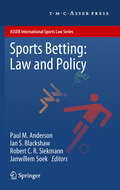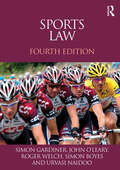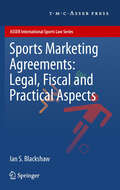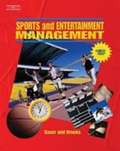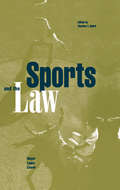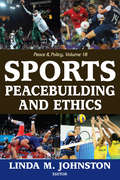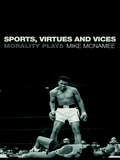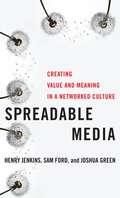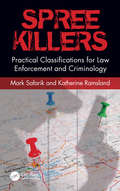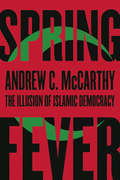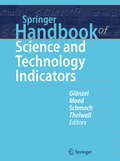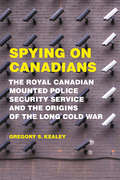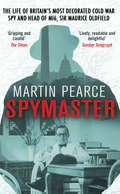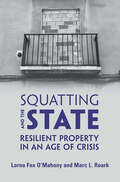- Table View
- List View
Sports Betting: Law and Policy
by Robert C.R. Siekmann Ian S. Blackshaw Janwillem Soek Paul M. AndersonGambling is a significant global industry, which is worth around 0.6% of world trade, that is, around US$ 384 billion; and gambling on the outcome of sports events is a very popular pastime for millions of people around the world, who combine a bet with watching and enjoying their favourite sports. But, like any other human activity, sports betting is open to corruption and improper influence from unscrupulous sports persons, bookmakers and others. Sports betting in the last ten years or so has developed and changed quite fundamentally with the advent of modern technology - not least the omnipresence of the Internet and the rise of on-line sports betting. This book covers the law and policy on sports betting in more than forty countries around the world whose economic and social development, history and culture are quite different. Several chapters deal with the United States of America. This book also includes a review of sports betting under European Union (EU) Law. The book appears in the ASSER International Sports Law Series, under the editorship of Dr. Robert Siekmann, Dr. Janwillem Soek and Marco van der Harst LL.M.
Sports Investigations Law and the ECHR: Collection, Use and Exchange of Intelligence (Routledge Research in Human Rights Law)
by Björn HessertThis book focuses on the analysis of coercive measures that sports organisations are permitted to use as part of their internal sports investigation proceedings to investigate sports rule violations. The legality of such coercive measures is measured against the legal regime of the European Convention on Human Rights (ECHR). The book examines the important issue of the applicability of the ECHR to private sports organisations, which is currently widely debated in the field of sports law. The ECHR is hereby used as the analytical framework, which should also be a source of inspiration for jurisdictions outside the scope of application of the ECHR. The book further explores if and to what extent sports organisations and law enforcement agencies may exchange intelligence in support of both internal sports investigation proceedings and criminal investigations. At all stages, the work seeks to strike a balance between the interest of sports organisations to investigate sports rule violations and the rights of athletes and other sportspersons. The work will be an invaluable resource for students, academics and policy-makers working in the area of Sports Law and Human Rights Law.
Sports Law
by John O'Leary Simon Gardiner Roger Welch Simon Boyes Urvasi NaidooLong established as the market leading textbook on sports law, this much-anticipated new edition offers a comprehensive and authoritative examination of the legal issues surrounding and governing sport internationally. Locating the legal regulation of sport within an explicit socio-economic context, this refocused edition is divided into four core parts: Governance & Sport; Commercial Regulation; Sports Workplace; and Safety in Sport. Recent developments covered in this edition include: EU competition law interaction with sport under arts. 101 and 102 of the Treaty on the Functioning of the European Union; the current World Anti-Doping Agency code; analysis of the recent Court of Arbitration for Sport Jurisprudence; reforms of the transfer system in team sports; anti-discrimination provisions in sport; engagement with match fixing; a focus on the legal context of 2012 London Olympics. Essential reading for students studying sports law or sports-related courses, this textbook will also prove useful to sports law practitioners and sports administrators in need of a clear companion to the field.
Sports Law: Governance and Regulation
by Rodney Smith Kenneth Shropshire Timothy Davis Matthew J. Mitten Barbara OsborneFrom coaches' and layers' legal contracts, to regulatory issues of race, gender, safety, and more -- Sports Law: Governance and Regulation covers the full range of topics for both amateur and professional sports.<P> By the authors of the best-selling law school casebook Sports Law and Regulations: Cases, Materials, and Problems, Sports Law: Governance and Regulation is authoritative and timely. Examples, cases, and problem exercises accessibly convey the role of law and policy in a variety of settings and from a variety of perspectives -- players', managers', coaches', and society's.
Sports Management in an Uncertain Environment (Sports Economics, Management and Policy #21)
by Michel Desbordes Bhaskar Basu Soumya SarkarThis edited book delves into several aspects of sports and sports management from a vantage of uncertainty and turbulence unleashed initially by COVID-19. The book, divided into three broad sections, deals in strategy and governance of sports organizations, use and evolution of technology in sports, and sports consumption and media. It starts from the backdrop of how sport assumed a new-found importance in people's lives while reeling under several phases of pandemic-induced lockdowns. Consumers felt how integral sports was in their lives when there were no live games to watch and bond on. Players, leagues, organizers, and media are still recovering, along with viewers, as sports makes a tentative comeback in our lives. COVID-19 was a precursor of the disruptions to come. Both the supply and demand sides have taken note of those disturbances to prepare themselves for any such potential derailments. The organizations, franchises, athletes, media, health care, logistics on sports have been reworking their strategies to keep coping with uncertainties. On the other hand, the consumers have transformed their sports consumption behavior over these two years, aided by the enormous technological changes. Such a backdrop paved the way for researchers to understand how the sports industry has dealt with this impact and has rediscovered itself to take its coveted spot. This book is a snapshot of several global sports changes and how they continue to evolve in an increasingly turbulent and uncertain world. It will be a rich resource not only for academics studying sports management, but also event management organizations, administrators, and policymakers.
Sports Marketing Agreements: Legal, Fiscal and Practical Aspects
by Ian S. BlackshawSports marketing is not only a global phenomenon, but also a major industry in its own right. This book breaks new ground in that it combines the theory and the practice of sports marketing agreements, which are at the heart of the commercialisation and marketing of sport. A particular feature of this book is the wide-ranging collection of precedents of sports marketing agreements, including, inter alia, sponsorship, merchandising, TV rights and new media, sports image rights and endorsements, event management and corporate hospitality, that are included and are explained and commented on in the text of the book. The book also covers the EU aspects, which are particularly important in this context, especially collective selling, of Sports TV rights and the drafting of the corresponding agreements; as well as the fiscal aspects of sports marketing agreements in general and sports image rights agreements in particular, which need to be taken into account in order to reduce the tax burden on the resulting revenues. With so much money at stake in sports marketing, the book also deals with the important topic of dispute resolution and, again, provides the reader with some useful corresponding clauses for settling disputes by ADR, particularly through the Court of Arbitration for Sport (CAS). As the author remarks in his Preface, the aim of the book is to provide a leading resource for all those engaged in any way in the money-spinning field of sports marketing, combining - as this book uniquely does - both the theory and the practice of drafting, interpreting and enforcing a variety of sports marketing agreements, especially those with an international dimension.
Sports and Entertainment Management
by Ken Kaser John R. Brooks Jr.Learn marketing and business management while focusing on sports with SPORTS AND ENTERTAINMENT MANAGEMENT. This marketing and business management textbook uses topics in the sports and entertainment industries to cover the basic functions of management as outlined in national and state standards. Along the way, you'll also discover powerful information about leadership, finance, product and people management, customer relations, sales, and much more.
Sports and Human Rights (Interdisciplinary Studies in Human Rights #10)
by Andreas R. Ziegler Sophie Weerts Véronique BoilletBased on a series of themes and case studies, this book aims to illustrate the impact of sports policies and practices on individuals and their identities, and to analyze the potential solutions offered by International human rights law (IHRL) for these infringements. It bridges the gap between IHRL and sports studies, and will be useful to scholars in both fields, especially those unfamiliar with each other’s work. Furthermore, by investigating the context of sport and its governance, this collection offers a series of valuable insights, enabling the development of an interpretation of ‘law in context’ for legal scholars in the field of human rights. As the governance and regulation of sport are seen as illustrations of other forms of normativity, this book also contributes to the conversation about the transnational dimension of law and legal orders. In this respect, it illustrates that normative autonomy in the field of sport, associated with the idea of lex sportiva, tends to be relative regarding IHRL. The sporting environment is not disconnected from major contemporary social issues: it constitutes a public space in which injustices can be denounced, but also the theater in which prejudices are perpetuated against various parties, such as athletes or workers. IHRL commonly addresses attacks on individual dignity and social justice issues by guaranteeing rights to individuals and offering them protection mechanisms. In this context, can IHRL solve the problems encountered in the sporting environment? This is the question that animates this volume. This is an open access book.
Sports and the Law: Major Legal Cases (American Law and Society #Vol. 04)
by Charles E. QuirkFirst Published in 1999. Routledge is an imprint of Taylor & Francis, an informa company.
Sports and the Law: Text, Cases and Problems
by Stephen F. Ross Paul C. Weiler Gary R. Roberts Roger I. AbramsThis casebook introduces students to the fundamentals of labor, antitrust, and intellectual property law as applied in the professional and amateur sporting industries. It covers the unique office of the league commissioner; the contract, antitrust, and labor law dimensions of the player-labor market; the peculiar institution of the player agent in a unionized industry; the economic and legal implications of agreements among league owners and responses to rival leagues; the system of commercialized college athletics governed by the NCAA and how law impacts individual sports like golf, tennis and boxing; as well as the structure and operation of international Olympic sports. It also covers issues of statutory interpretation, administrative law, and torts before a variety of forums, including state and federal courts, agencies, and arbitration. The new edition updates material on the business of sports with the latest antitrust, preemption, drug testing and labor relations cases.
Sports, Peacebuilding and Ethics (Peace And Policy Ser.)
by Linda M. JohnstonAs this latest volume in the Peace & Policy series shows, sports can be an effective mechanism for peacebuilding, especially when incorporated into conflict-resolution programs. Such programs have been designed to bring children together in post-conflict situations with an ultimate goal of reducing future violence. In examining such programs, the volume's contributors ask key questions: "What are the programs achieving?" and "How are they measuring success?" Although such programs have by and large been successful, some issues need to be addressed if these programs are to hone their effectiveness.Among the questions explored in the volume are: various aspects of culture and how they can help shape sports programs; the role of a coach in creating a culture of peace, and how this culture can fit into a peacebuilding process. Contributors also examine the role of sports in trauma relief programs in Rwanda; the role of universities in sports; and the role of sports in the demilitarization of child soldiers.The last three contributors tackle some of the legitimate concerns raised about using sports for peacebuilding, such as sports being competitive, violent, and focused on winning. Contributors look carefully at these and other issues that have arisen in sports as a tool of conflict resolution, discuss why they have become concerns, and consider some possible ways to deal with these concerns in the future.
Sports, Virtues and Vices: Morality Plays
by Mike McNameeSports have long played an important role in society. By exploring the evolving link between sporting behaviour and the prevailing ethics of the time this comprehensive and wide-ranging study illuminates our understanding of the wider social significance of sport. The primary aim of Sports, Virtues and Vices is to situate ethics at the heart of sports via ‘virtue ethical’ considerations that can be traced back to the gymnasia of ancient Greece. The central theme running through the book is that sports are effectively modern morality plays: universal practices of moral education for the masses and - when coached, officiated and played properly - a valuable vehicle for ethical development. Including a wealth of contemporary sporting examples, the book explores key ethical issues such as: How the pursuit of sporting excellence can lead to harm Doping, greed and shame Biomedical technology as a challenge to the virtue of elite athletes Defining a ‘virtue ethical account’ in sport Family vices and virtues in sport Written by one of the world's foremost sports philosophers, this book powerfully unites the fields of sports ethics and medical ethics. It is essential reading for all students and scholars with an interest in the ethics and philosophy of sport.
Spreadable Media: Creating Value and Meaning in a Networked Culture (Postmillennial Pop #15)
by Henry Jenkins Sam Ford Joshua GreenHow sharing, linking, and liking have transformed the media and marketing industries Spreadable Media is a rare inside look at today’s ever-changing media landscape. The days of corporate control over media content and its distribution have been replaced by the age of what the digital media industries have called “user-generated content.” Spreadable Media maps these fundamental changes, and gives readers a comprehensive look into the rise of participatory culture, from internet memes to presidential tweets. The authors challenge our notions of what goes “viral” and how by examining factors such as the nature of audience engagement and the environment of participation, and by contrasting the concepts of “stickiness”—aggregating attention in centralized places—with “spreadability”—dispersing content widely through both formal and informal networks. The former has often been the measure of media success in the online world, but the latter describes the actual ways content travels through social media. The book explores the internal tensions businesses face as they adapt to this new, spreadable, communication reality and argues for the need to shift from “hearing” to “listening” in corporate culture. Now with a new afterword addressing changes in the media industry, audience participation, and political reporting, and drawing on modern examples from online activism campaigns, film, music, television, advertising, and social media—from both the US and around the world—the authors illustrate the contours of our current media environment. For all of us who actively create and share content, Spreadable Media provides a clear understanding of how people are spreading ideas and the implications these activities have for business, politics, and everyday life, both on- and offline.
Spree Killers: Practical Classifications for Law Enforcement and Criminology
by Katherine Ramsland Mark SafarikSpree Killers: Practical Classifications for Law Enforcement and Criminology is the only exhaustive, up-to-date analytical book on spree killers, standing apart from those dedicated to mass murderers and serial killers. Multicides have traditionally been categorized as double, triple, mass, serial and spree— while, mass and serial have been further divided into subcategories. Spree killing, which involves the killing of at least three persons at two or more locations due to a precipitating incident that fuels the urge to kill, remains a poorly defined concept. In the United States, the Federal Bureau of Investigation (FBI) eliminated this term from its multicide nomenclature in 2005, but the authors examination of 359 cases involving 419 spree killers from 43 countries shows that not only is there enough diversity among spree killers to form classifications—similar to those devised for mass and serial—but also that subtypes offer distinct utility for identification, tracking, and warning potential targets. Spree Killers outline the designation of spree killer specifically and thoroughly. In addition to looking at existing literature, specific cases, and the behavioral patterns, it offers a fully worked up profile for the typology. The behaviors and motives for spree killers align in six categories, which are detailed in full. The book provides unique insight for police, forensic, and investigative personnel into what to look for to respond to, and—in some cases identify and stopping—certain types of spree killings.
Spring Fever
by Andrew C MccarthyThe first fundamental truth about the "Arab Spring" is that there never was one. The salient fact of the Middle East, the only one, is Islam. The Islam that shapes the Middle East inculcates in Muslims the self-perception that they are members of a civilization implacably hostile to the West. The United States is a competitor to be overcome, not the herald of a culture to be embraced.Is this self-perception based on objective truth? Does it reflect an accurate construction of Islam? It is over these questions that American officials and Western intellectuals obsess. Yet the questions are irrelevant. This is not a matter of right or wrong, of some posture or policy whose subtle tweaking or outright reversal would change the facts on the ground. This is simply, starkly, the way it is.Every human heart does not yearn for freedom. In the Islam of the Middle East, "freedom" means something very nearly the opposite of what the concept connotes to Westerners - it is the freedom that lies in total submission to Allah and His law. That law, sharia, is diametrically opposed to core components of freedom as understood in the West - beginning with the very idea that man is free to make law for himself, irrespective of what Allah has ordained. It is thus delusional to believe, as the West's Arab Spring fable insists, that the region teems with Jamal al-Madisons holding aloft the lamp of liberty. Do such revolutionary reformers exist? Of course they do . . . but in numbers barely enough to weave a fictional cover story. When push came to shove - and worse - the reformers were overwhelmed, swept away by a tide of Islamic supremacism, the dynamic, consequential mass movement that beckons endless winter.That is the real story of the Arab Spring - that, and the Pandora's Box that opens when an American administration aligns with that movement, whose stated goal is to destroy America.
Springer Handbook of Science and Technology Indicators (Springer Handbooks)
by Ulrich Schmoch Henk F. Moed Mike Thelwall Wolfgang GlänzelThis handbook presents the state of the art of quantitative methods and models to understand and assess the science and technology system. Focusing on various aspects of the development and application of indicators derived from data on scholarly publications, patents and electronic communications, the individual chapters, written by leading experts, discuss theoretical and methodological issues, illustrate applications, highlight their policy context and relevance, and point to future research directions.A substantial portion of the book is dedicated to detailed descriptions and analyses of data sources, presenting both traditional and advanced approaches. It addresses the main bibliographic metrics and indexes, such as the journal impact factor and the h-index, as well as altmetric and webometric indicators and science mapping techniques on different levels of aggregation and in the context of their value for the assessment of research performance as well as their impact on research policy and society. It also presents and critically discusses various national research evaluation systems.Complementing the sections reflecting on the science system, the technology section includes multiple chapters that explain different aspects of patent statistics, patent classification and database search methods to retrieve patent-related information. In addition, it examines the relevance of trademarks and standards as additional technological indicators.The Springer Handbook of Science and Technology Indicators is an invaluable resource for practitioners, scientists and policy makers wanting a systematic and thorough analysis of the potential and limitations of the various approaches to assess research and research performance.
Spurious Economy for All
by Claudio Pardo MolinaMany modern leaders want to install into the common sense of the masses that economics is bad because economics is synonymous with capitalism. And they do it through countless spurious examples that I will be giving throughout this book. I will use the term Spurious thinking of synonyms such as illegitimate, adulterated, counterfeit, imitated, fraudulent and false. And these spurious examples are given when they explain economic problems with a part of the whole theory because the only purpose is to discredit this social science. Because as mothers and grandmothers tell us as children "A half truth is also a lie."
Spy Plane: Inside Baltimore's Surveillance Experiment
by Benjamin H. SnyderAn exclusive behind-the-scenes look at one of America’s most controversial experiments in police surveillance. In 2020, the Baltimore Police Department had an aerial surveillance plane that could supposedly photograph and track every person in public view. Spy Plane reveals what happened with this controversial policing experiment. Drawing from incredible access and direct observations inside the for-profit tech startup that ran the program for Baltimore detectives, sociologist Benjamin H. Snyder recounts real criminal cases as they were worked by police using this untested tool. Deploying aircraft with powerful cameras built by a small company called Persistent Surveillance Systems, the spy plane program promised to help police "solve otherwise unsolvable crimes" by tracking the whereabouts of suspects in violent crime cases. Created for the battlefields of Iraq, it had never been adapted on so large a scale in a U.S. city. This riveting book gives an unprecedented look inside the shadowy world of for-profit law enforcement technology experiments, explaining why police and community leaders place so much faith in unproven technology to fix the problem of urban violence but continually come up short.
Spygate: The Attempted Sabotage Of Donald J. Trump
by Dan Bongino D. C. McAllister Matt Palumbo<P><P>Everyone has an opinion about whether or not Donald Trump colluded with the Russians to defeat Hillary Clinton in 2016. The number of actors involved is staggering, the events are complicated, and it’s hard to know who or what to believe. Spygate bypasses opinion and brings facts together to expose the greatest political scandal in American history. <P><P> Former Secret Service agent and NYPD police officer Dan Bongino joins forces with journalist D.C. McAllister to clear away fake news and show you how Trump’s political opponents, both foreign and domestic, tried to sabotage his campaign and delegitimize his presidency. By following the names and connections of significant actors, the authors reveal: Why the Obama administration sent a spy connected to the Deep State into the Trump campaign How Russians were connected to the opposition research firm hired by the Clinton campaign to find dirt on Trump How the FBI failed to examine DNC computers after they were hacked, relying instead on the findings of a private company connected to the DNC and the Obama administraton Why British intelligence played a role in building the collusion narrative What role Ukrainians played in legitimizing the perception that Trump was conspiring with the Russians How foreign players in the two events that kickstarted the Trump-Russia collusion investigation were connected to the Clinton Foundation, and What motivated the major actors who sought to frame the Trump campaign and secure a win for Hillary Clinton
Spying on Canadians: The Royal Canadian Mounted Police Security Service and the Origins of the Long Cold War
by Gregory S. KealeyAward winning author Gregory S. Kealey’s study of Canada’s security and intelligence community before the end of World War II depicts a nation caught up in the Red Scare in the aftermath of the Bolshevik Revolution and tangled up with the imperial interests of first the United Kingdom and then the United States. Spying on Canadians brings together over twenty five years of research and writing about political policing in Canada. Through itse use of the Dominion Police and later the RCMP, Canada repressed the labour movement and the political left in defense of capital. The collection focuses on three themes; the nineteenth-century roots of political policing in Canada, the development of a national security system in the twentieth-century, and the ongoing challenges associated with research in this area owing to state secrecy and the inadequacies of access to information legislation. This timely collection alerts all Canadians to the need for the vigilant defence of civil liberties and human rights in the face of the ever increasing intrusion of the state into our private lives in the name of countersubversion and counterterrorism.
Spying on Democracy
by Lewis Lapham Heidi Boghosian"Everyone of us is under the omniscient magnifying glass of the government and corporate spies. . . . How do we respond to this smog of surveillance? Start by reading Spying on Democracy: Government Surveillance, Corporate Power, and Public Resistance by Heidi Boghosian"--Bill Moyers"With ex-CIA staffer Edward Snowden's leaks about National Security Agency surveillance in the headlines, Heidi Boghosian's Spying on Democracy: Government Surveillance, Corporate Power, and Public Resistance feels especially timely. Boghosian reveals how the government acquires information from telecommunications companies and other organizations to create databases about 'persons of interest.'" -- Publishers Weekly"Heidi Boghosian's Spying on Democracy is the answer to the question, 'if you're not doing anything wrong, why should you care if someone's watching you?'"-Michael German, Senior Policy Counsel, ACLU and former FBI agentUntil the watershed leak of top-secret documents by Edward Snowden to the Guardian UK and the Washington Post, most Americans did not realize the extent to which our government is actively acquiring personal information from telecommunications companies and other corporations. As made startlingly clear, the National Security Agency (NSA) has collected information on every phone call Americans have made over the past seven years. In that same time, the NSA and the FBI have gained the ability to access emails, photos, audio and video chats, and additional content from Google, Facebook, Yahoo, Microsoft, YouTube, Skype, Apple, and others, allegedly in order to track foreign targets.In Spying on Democracy, National Lawyers Guild Executive Director Heidi Boghosian documents the disturbing increase in surveillance of ordinary citizens and the danger it poses to our privacy, our civil liberties, and to the future of democracy itself. Boghosian reveals how technology is being used to categorize and monitor people based on their associations, their movements, their purchases, and their perceived political beliefs. She shows how corporations and government intelligence agencies mine data from sources as diverse as surveillance cameras and unmanned drones to iris scans and medical records, while combing websites, email, phone records and social media for resale to third parties, including U.S. intelligence agencies.The ACLU's Michael German says of the examples shown in Boghosian's book, "this unrestrained spying is inevitably used to suppress the most essential tools of democracy: the press, political activists, civil rights advocates and conscientious insiders who blow the whistle on corporate malfeasance and government abuse." Boghosian adds, "If the trend is permitted to continue, we will soon live in a society where nothing is confidential, no information is really secure, and our civil liberties are under constant surveillance and control." Spying on Democracy is a timely, invaluable, and accessible primer for anyone concerned with protecting privacy, freedom, and the U.S. Constitution.Heidi Boghosian is the Executive Director of the National Lawyers Guild. She co-hosts Law and Disorder, broadcast on WBAI-FM in New York and over forty stations nationwide. She is based in New York City.
Spymaster: The Life of Britain's Most Decorated Cold War Spy and Head of MI6, Sir Maurice Oldfield
by Martin Pearce'I cannot think of a better biography of a spy chief'Richard Davenport-Hines, The SpectatorSir Maurice Oldfield was one of the most important British spies of the Cold War era. _________A farmer’s son from a provincial grammar school who found himself accidentally plunged into the world of espionage, Sir Maurice was the first Chief of MI6 who didn’t come to the role via the traditional public school and Oxbridge route. Oldfield was the voice of British Intelligence in Washington at the time of the Cuban Missile Crisis and the assassination of JFK, and was largely responsible for keeping the UK out of the Vietnam War. Working his way to the top of the secret service, he took on the job of rebuilding confidence in the British Secret Service in the wake of the Philby, Burgess and Maclean spy scandals.This is the fascinating life story, told in detail for the first time, of a complex, likeable character as well as a formidable intelligence chief.
Spätverfolgung von NS-Unrecht
by Moritz Vormbaum75 Jahre nach dem Nürnberger Hauptkriegsverbrecherprozess ist die Strafverfolgung der nationalsozialistischen Systemverbrechen faktisch abgeschlossen. Der Band nimmt den letzten Akt der Strafverfolgung von NS-Unrecht in Deutschland in den Blick. Er knüpft an die in Wissenschaft, Praxis und allgemeiner Öffentlichkeit geführten Debatten über die Spätverfolgung an, zu einem Zeitpunkt, an dem die Erinnerung an die Verfahren noch frisch ist. Disziplinenübergreifend bietet der Band Analysen verschiedener Aspekte der Spätverfolgung und verknüpft das Thema mit dem internationalen "transitional justice"-Diskurs.Die Kapitel 1 Einführung, 11 Spätverfolgung von NS-Unrecht – Reflexionen der Nebenklagevertretung und 20 Ausgeforscht? Zeitgeschichte und juristische Ahndung von NS-Verbrechen sind unter einer Creative Commons Attribution 4.0 International License über link.springer.com frei verfügbar (Open Access).
Squatting and the State: Resilient Property in an Age of Crisis
by Lorna Fox O'Mahony Marc L. RoarkSquatting and the State offers a new theoretical and methodological approach for analyzing state response to squatting, homelessness, empty land, and housing. Embedded in local, national, and transnational contexts, and reaching beyond conventional property theories, this important work sets out a fresh analytical paradigm for understanding the deep, interlocking problems facing not just the traditional 'victims' of narratives about homelessness and squatting but also a variety of other participants in these conflicts. Against the backdrop of economic, social, and political crises, Squatting and the State offers readers important insights about the changing natures of property, investment, housing, communities, and the multi-level state, and describes the implications of these changes for how we think and talk about property in law.
Srebrenica in the Aftermath of Genocide
by Lara J. Nettelfield Sarah E. WagnerThe fall of the United Nations "safe area" of Srebrenica in July 1995 to Bosnian Serb and Serbian forces stands out as the international community's most egregious failure to intervene during the Bosnian war. It led to genocide, forced displacement, and a legacy of loss. But wartime inaction has since spurred numerous postwar attempts to address the atrocities' effects on Bosnian society and its diaspora. Srebrenica in the Aftermath of Genocide reveals how interactions between local, national, and international interventions - from refugee return and resettlement to commemorations, war crimes trials, immigration proceedings, and election reform - have led to subtle, positive effects of social repair, despite persistent attempts at denial. Using an interdisciplinary approach, diverse research methods, and more than a decade of fieldwork in five countries, Lara J. Nettelfield and Sarah E. Wagner trace the genocide's reverberations in Bosnia and abroad. The findings of this study have implications for research on post-conflict societies around the world.
